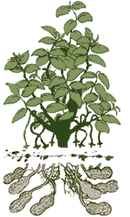|
|
|
|
|
|
 |
Records indicate the good ole peanut has been around for 3500 years or so. Its original home is thought to be on the lower eastern slopes of the Andes in what is now Brazil or Peru, Peanuts were grown as far north as Mexico by the time the Spanish began their exploration of the New World. The explorers took peanuts back to Spain, where they are still grown. From Spain, traders and explorers took peanuts to Africa and Asia. In Africa the plant became common in the western tropical region. The peanut was regarded by many Africans as one of several plants possessing a soul.
The first major uses for peanuts were as food for pigs. The first commercial growth of peanuts is generally attributed to the Poplar Grove Plantation at Scotts Hill located north of Wilmington, North Carolina. The first notable use of peanuts as food for humans came during the Civil War, when both Northern and Southern troops used the peanut as a food source during hard times. |
|

Dr. George Washington Carver is known as the father of the commercial peanuts. In 1903, he began research at the Tuskeegee Institute in Alabama, The talented botanist recognized the intrinsic vale of the peanut as a cash crop. Dr. Carver proposed that peanuts be planted as a rotation crop in the Southeast cotton-growing areas where the boil weevil insect threatened the region's agricultural base. Not only did Dr. Carver contribute to changing the face of southern farming, but he also developed more than 300 uses for peanuts, mostly for industrial purposes, including cheese, mayonnaise,chili sauce,bleech shampoo, axle grease, linoleum and ice cream. |
|
|
|
 |
The peanut is unusual because it flowers above the ground, but fruits below the ground. Typical misconceptions of how peanuts grow place them on trees ( like walnuts or pecans ) or growing as a part of a root, like potatoes. Peanut seeds are planted about two inches deep, one every three or four inches, in rows about three feet apart. The seeds do best in sandy soil, especially soil rich in calcium. Chinese peanut is planted in the sandy soil in April or May when the soil temperature is warm(abt.18 C). the seeds will sprout by given enough water. In about two weeks, the first "square" of four leaflets will unfold above the peanut field. Thirty to forty days after emergence the plants bloom, "pegs" form and enter the soil. The peanut shells and kernels develop and mature during the next 60 to 70 day period. Depending on the variety and the region, 120 to 165 frost free days are required for a good crop.In order to reduce aflatoxin, weeds and diseases of all kinds, Chinese farmers generally follow a three-year rotation pattern with wheat, corn, cotton or small grains planted on the same acreage in intervening years. In addition, farmers are utilizing irrigation in an effort to reduce crop stress, especially during times of drought, and thereby enhance opportunities for the production of high quality peanuts.Peanuts are harvested from August through November in China when peanuts are ripe. Harvesting is done by hand. The plants together with the peanut shells are left on the ground for two or three days to be dried in the sun to remove the moisture, then farmers separate the peanut shells from foliage and stems and further dry in the sun until the moisture is reduced to 8-10 percent for safe storage and transportation. |
|
| Types of Peanuts TOP |
|
Many are surprised to discover that the peanut is actually not a nut at all. In fact, it is a legume and belongs to the pea family. The peanut probably has been given more names throughout history than any other food. Some nutty names given to the peanut include: goober, groundnut, monkey nut, earthnut and ground pea, just to name a few. Today in Spain, the peanut is call Mani, pronounced my-knee. In Greece the peanut is called Fystiki, pronounced fee-stee-kee. In France, the peanut is called Cacahuete, pronounced ka-ka-wet. In Germany, the peanut is called Erdnuss, pronounced airdnoose. And in Russia, the peanut is called Zemlyanoy Grek, pronounced zem-ya-noy arek.
Although peanuts come in many varieties, there are four basic market types: Hsuji Type, Virginia Type, Valencia Type and Ji You 4 Type. Each of the peanut types is distinctive in size, flavor, and nutritional composition. |
|
|
Hsuji Type
Hsuji type has attractive, uniform kernel size and a round to oval shape, mainly used for peanut butter. Hsuji type is grown mainly in Shandong, Liaoning, Hebei, Henan and Anhui Province. |
|
Virginia Type
Virginias have the largest kernels and account for most of the peanuts roasted and processed in-the-shell. When shelled, the larger kernels are sold as snack peanuts. Virginias are grown mainly in Henan, Shangdong and Hebei.
|
|
 |
Valencia
Valencias usually have three or more small kernels to a pod and are covered in a bright-red skin. They are very sweet peanuts and are usually roasted and sold in-the-shell. They are also excellent for fresh use as boiled peanuts,they are mainly grown in Northeast China. |
|
Ji you 4
It usually has three giant kernels to pod. They are sweat and are usually roasted and sold in shell. They are mainly grown in Hebei and Henan Provinces. Within each four basic types of peanuts, there are several "varieties" for seed and production purposes. Each variety contains distinct characteristics which allows a producer to select the peanut that is best suited for its region and market. |
|
| Where Peanuts Grow TOP |
|
Peanuts are grown in the warm climates of Asia, Africa, Australia, and North and South America. China and india together account for more than half of the world's production. The United States has about 3% of the world acreage of peanuts, but grows nearly 10% of the world's crop because of higher yields per acre. Other major peanut growing countries include Senegal, Sudan, Brazil, Argentina, South Africa, Malawi, and Nigeria. In China, these are the major peanut producing provinces: HENAN, SHANDONG, LIAONING and HEBEI
We Offer Coated Peanut, Blanched Peanut, Peanut Roasted Peanut Salted, Peanut Shelling,Virginia Salted Peanuts from China.
|
|
China Weather

PROVINCE |
TONNAGE (x10,000) |
HARVEST PERIOD |
| Henan |
293 |
From Sep. To Nov |
| Shandong |
300 |
From Sep. To Nov |
| Hebei |
|
From Sep. To Nov |
| Liaoning |
16.6 |
From Sep. To Nov |
|
|
|
| |
|










